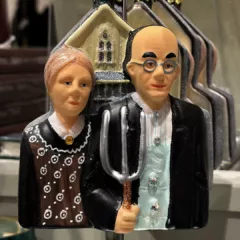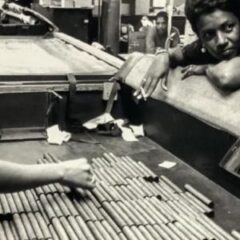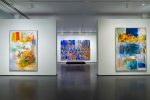No photography has had the effect on me of Robert Frank’s The Americans, which I saw in 1969 at the Philadelphia Museum of Art. It was not just that Frank showed the family of man complete with its disfunction, feuds and black sheep, but the disturbing power of his vision.
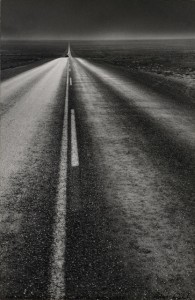
It emphasized the necessity of art to present a complex and unresolved picture in place of the one-line pitch provided by the commercial world. In Cold War America of the 50s and well into the 60s everyone was blond, smiling and beautiful; it seemed the entire country, as in Lake Woebegon, was above average.
The National Gallery of Art is showing Looking In; Robert Frank’s “The Americans” through April 26, before it moves to the San Francisco Museum of Modern Art (May 17-August 23) and the Metropolitan Museum of Art (September 22-December 27, 2009). The exhibition traces the background of The Americans in Frank’s previous books and series of images as well as books of photographs by his mentors and contemporaries. It includes numerous contact sheets from the 767 rolls of film Frank shot and then culled to the 83 images in The Americans, mock-ups of his collages of images that were part of his editing process and correspondence with the Guggenheim Foundation (which funded his photographic project), Jack Kerouac (whom Frank asked to write an introduction to the book) and others connected with the project. The exhibition makes plain the enormous work and calculation behind The Americans’s seeming artlessness.
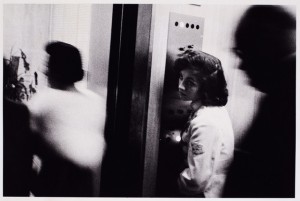
Indeed it may be hard for younger viewers to realize the novelty of Frank’s work, so thoroughly have his lessons been assimilated. Frank went for the ordinary and avoided the picturesque or photogenic. He retained the homely details that were cropped or air-brushed out of commercial photographs: a woman’s chipped and dirty fingernails, the tangle of cords in a television studio, a clutter of signs in the landscape. He included both over and under-lit images and odd camera angles to imply the un-studiedness, and hence truthfulness, of his work.
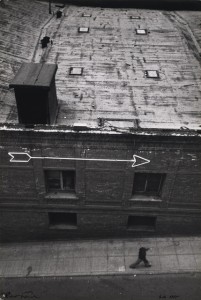
Frank was a poet of the nocturnal, both outdoors and under harsh, indoor lighting. He enjoyed scenes that were unlikely, as well as unknown in his European experience: a cowboy in Western hat and boots in New York City, drive-in movies, religious expressions on the rear windshields and bumpers of cars, racial segregation, the prevalence of commercial signage and automobiles, lots of automobiles. If Frank was ever invited into an American home he left his camera behind. He showed Americans in public, both alone and in crowds. And Frank was a self-conscious witness; in San Francisco he showed a couple from behind, relaxing on the grass, the man looking over his shoulder and glowering at the photographer whose presence impinges on them.
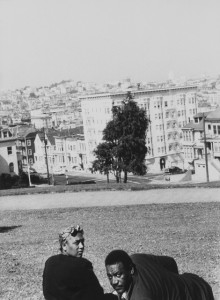
The Americans was a product of one of the mid-century’s classic road trips, but Frank’s roads lead to death (Car Accident – U.S. 66, between Winslow and Flagstaff, Arizona, 1955, Crosses on scene of highway accident – U.S. 91, Idaho, 1956), desolation (Santa Fe, New Mexico, 1955) and religion (St. Francis, gas station, and City Hall – Los Angeles, 1956) as well as discovery and escape; it was as conscious a narrative as the various books and films of the genre. The work was first published in France in 1959 (with texts that were not of Frank’s choosing) then in 1960 by Grove Press, with Kerouac’s introduction, and multiple times since; numerous editions are included in the exhibition. The curator, Sarah Greenough, is clear that she is showing rarely exhibited vintage prints – an imposition of market and museum values on a series of photographs that were intended for reproduction. I could distinguism more variation among the printed editions (the 1969 MoMA edition pushed the contrast so that the pictures have an entirely different impression) than I could between the earlier and later prints of the photographs. The National Gallery’s reproductions in its catalog are tritones and certainly superior to all previous versions. The comprehensive catalog (ISBN 978-3-86521748-6) is available in an expanded, hardcover edition (ISBN 978-3-86521-806-3 – distributed by D.A.P.) that includes all of Frank’s contact sheets for The Americans, a comparative sequencing for published editions, further correspondence, a map and chronology. Both versions are extraordinarily beautifully designed by Margaret Bauer. The catalog gives this body of work the documentation and anaylsis it certainly deserves.


